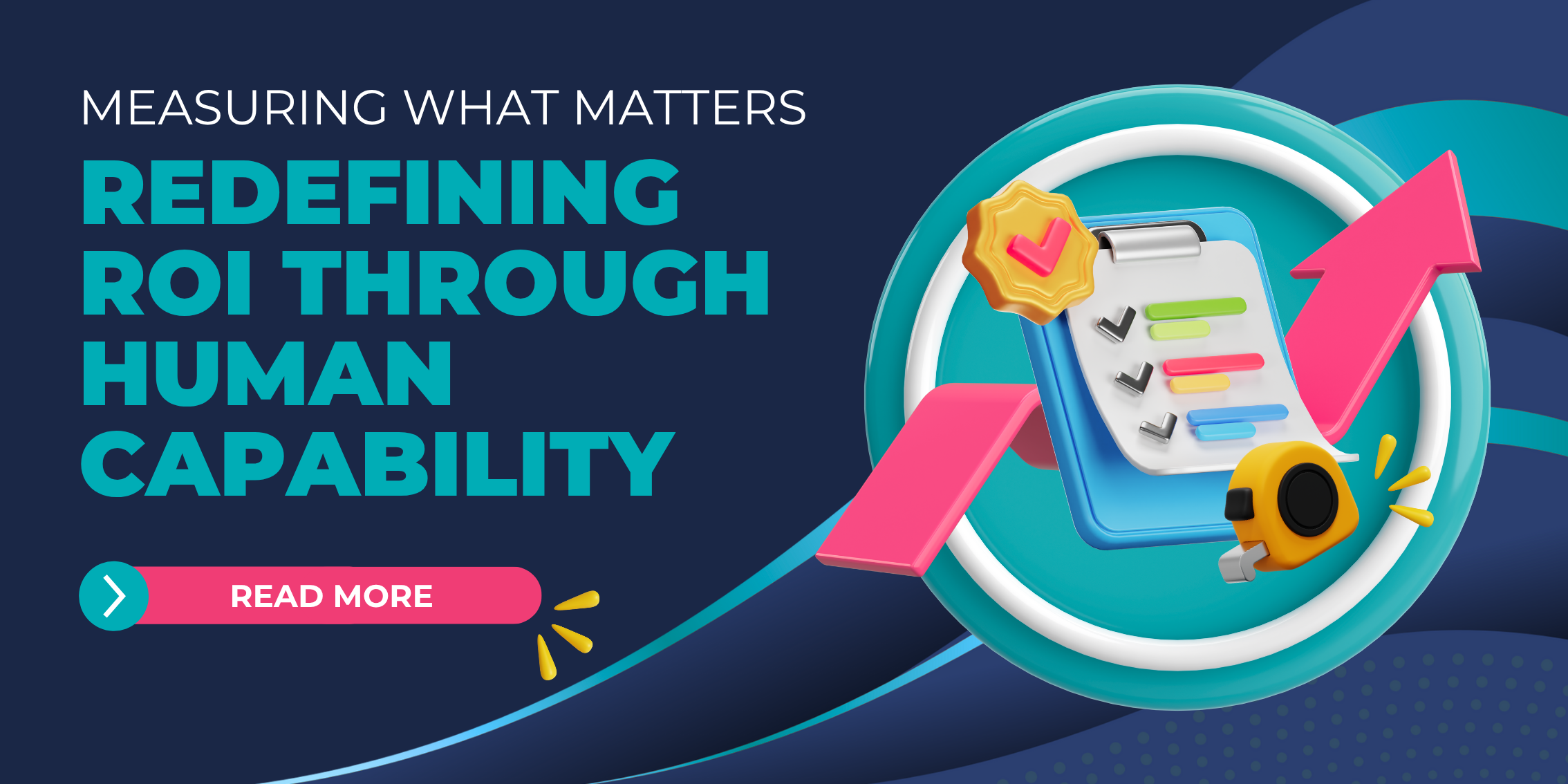
Measuring What Matters: Redefining ROI Through Human Capability
By Chantelle Kohn
Completion rates are up. Self-assessments look impressive. Learner satisfaction surveys are glowing. But are people actually changing how they work? Are teams collaborating more effectively? Are organisational cultures evolving and seeing higher levels of wellbeing and performance?
Too often, these questions go unanswered because Learning and Development (L&D) is still measured in ways designed for another era - one focused on information delivery, not transformation.
It’s not about moving beyond ROI. It’s about redefining it - so that what we measure reflects the real return on learning: better thinking, stronger relationships, and more effective systems that result in higher performance. When we do that, our measurements don’t just prove value - they create it.
Why Traditional ROI Metrics Fall Short (and Why They Persist)
It’s easy to see why many L&D teams still rely on metrics like completion rates, quiz scores, and satisfaction surveys. They’re simple to collect, easy to report, and familiar to stakeholders. They offer the comfort of numbers - clear, trackable, comparable.
But they tell only part of the story. They focus on outputs rather than outcomes. A leadership program might earn high praise and even a positive ROI calculation, yet six months later, team conflict remains unresolved and collaboration hasn’t improved. The learning happened, but the change didn’t.
This isn’t a failure of L&D professionals; it’s a reflection of the systems they operate in. Many organisations still judge L&D by efficiency (how many people completed a course) rather than effectiveness (how deeply people have changed). And with competing priorities and tight reporting cycles, it’s no surprise the sector defaults to what’s easily measurable instead of what’s most meaningful.
From Learning Events to Capability Building
In today’s digital landscape (where AI can instantly generate content, answer questions, and even deliver personalised learning) measuring knowledge and satisfaction is no longer enough. AI can replicate information, but not human growth.
Traditional metrics come from a training mindset: learning as an event, delivered and done. Yet the outcomes organisations seek today (such as leadership maturity, trust, psychological safety, adaptability and wellbeing), emerge only through practice, reflection, and feedback over time.
That’s the difference between content delivery and capability development.
If what we’re developing is human capability, then what we should be measuring is growth - in awareness, behaviour, and system impact.
These outcomes can be grouped into three meaningful dimensions:
- Behavioural outcomes: Observable changes in actions, decision-making, or practices. Are people applying new skills consistently? Are leaders demonstrating new habits in meetings, client interactions, or decision-making?
- Relational outcomes: Improvements in trust, communication, collaboration, and psychological safety. Do teams feel safe to share ideas, challenge assumptions, and navigate conflict more constructively?
- Systemic outcomes: Shifts in organisational processes, policies, or culture that enable sustainable change. Has feedback become a regular team practice? Are structures and incentives aligned with the organisation and team values?
These outcomes are harder to measure than course completions or test scores but far more indicative of long-term value. Research shows that organisations investing in relational and systemic development are more adaptive, innovative, and resilient - which is exactly what workplaces need in today’s rapidly changing digital era.
From Proof to Progress: Reframing ROI for the Digital Era
Stakeholders often ask L&D to “prove” ROI in financial terms. Yet learning rarely produces linear, immediate returns, especially when the goal is behavioural or cultural change.
Instead of treating ROI as a single number, L&D can reframe it as a story of progress: connecting leading indicators (behavioural shifts, capability growth, psychological safety) with lagging indicators (performance, engagement, retention).
For instance:
- A leadership program that improves feedback quality and trust may lead to higher engagement and productivity months later.
- A wellbeing capability initiative that builds self-regulation and boundary-setting may reduce burnout and absenteeism over time.
Learning itself isn’t the final product. It’s the starting condition for sustainable change.
Practical Ways to Measure Impact Differently
Measuring behavioural, relational, and systemic outcomes is absolutely possible and many L&D teams are already starting to evolve their approach.
Here are some practical ways to begin:
- Blend quantitative and qualitative data. Numbers matter, but stories bring them to life. Pair pulse survey data with reflection insights or peer feedback to show the depth of change.
- Measure at multiple levels. Track growth across personal (behaviour), team (relationships), and organisational (systems) dimensions. The interplay between them often reveals the true ROI.
- Use behavioural indicators. Replace “Did you enjoy the program?” with “How often are leaders using open-ended questions in team meetings?”
- Try ripple-effect mapping. Visualise how learning influences not just individuals but the teams and functions they touch.
- Embed continuous feedback loops. Move from post-program evaluation to ongoing learning intelligence through monthly pulse checks or “learning diaries.”
When L&D data combines hard metrics with human insight, it stops being a retrospective report and becomes a strategic asset.
Communicating Impact that Resonates
Measurement is only half the equation. Communication matters just as much. Traditional dashboards and spreadsheets often fail to convey the richness of learning outcomes.
Instead of leading with numbers alone, combine them with narratives that connect human change to business value:
“Conflict navigation training improved team trust scores by 18%, reducing project delays by 20%.”
“Managers report higher psychological safety, enabling faster and more open feedback cycles.”
“A shift in leadership behaviour has led to clearer decisions and higher engagement.”
Stories like these build credibility and make the human impact of L&D visible to stakeholders.
The Strategic Opportunity for L&D
This isn’t just a measurement challenge. It’s a mindset shift.
As the workforce evolves and AI reshapes what’s possible, L&D’s greatest opportunity is to build the human capabilities that drive wellbeing, trust, and performance. To do that credibly, we must measure what truly matters: not just completion, but connection. Not just learning, but change.
Measuring growth in capability reframes L&D as a core driver of organisational performance - not a learning service, but a strategic system for improving how people think, collaborate, and perform. That’s what meaningful ROI really looks like.
About the Author: Chantelle Kohn

Chantelle Kohn is an educator, facilitator, and culture change specialist with 15 years of global experience helping people and organisations thrive. As Founder and Director of The Change Collab, she partners with leaders and teams to strengthen the human capabilities that enable people to lead well, relate well, and live well. Guided by a belief that people and performance thrive together, she helps build cultures where wellbeing, engagement, and performance align for sustained impact.
Learn more: www.thechangecollab.com



